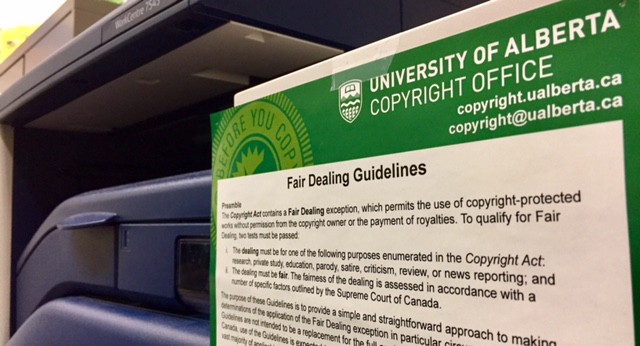
Instructors at educational institutions often display copyright-protected materials in classes or distribute excerpts from such materials to students. Copyright law tries to promote the broader public good by balancing the economic interests of creators in benefiting from their works with the interests of users to access, draw from, and build on those works. To that end, the Copyright ActCopyright Act gives specific recognition to the use of copyright-protected materials for education.
In 2016–17, the University of Alberta Libraries spent over $25 million purchasing and licensing copyright-protected content for use by faculty, staff members, and students. These licences grant access to a broad range of electronic resources, allowing their use for a number of educational and research purposes. It is generally only when resources or uses are required that are in addition to those included under these licences that the university or its faculty need to consider fair dealing or the other provisions in the Copyright Act to allow the use of those additional resources for educational purposes.
Much of the discussion around the federal government’s upcoming formal review of the Copyright Act involves fair dealing for educational purposes. The publishing industry has been losing revenue in recent years, and its representatives have raised concerns over the impact on that industry of the recent addition in the Copyright Act of education as a purpose under fair dealing. However, it has been well documented that the downward trend in that industry had commenced well before the Copyright Modernization Act came into force in 2012. Nevertheless, fair dealing for education has been under attack, and it will likely be carefully looked at as part of the formal review of the Act that is scheduled to commence shortly.
Section 29 of the Copyright Act states that “[f]air dealing for the purpose of private study, research, education, parody or satire does not infringe copyright.” The Act does not go into specific detail regarding the scope of what might count as fair dealing for the purpose of education, but future court decisions will add additional clarity. Nevertheless, it is important to note that the fairness of the use has always been the standard when applying fair dealing, and this standard was not changed by the addition in 2012 of “education” as a purpose that permits fair dealing. The Supreme Court of Canada has provided considerable guidance through a number of decisions on how to make such determinations of fairness, and those determinations include appropriate consideration of any adverse economic impact to the rights-holder from the desired use.
The University of Alberta has a set of Fair Dealing Guidelines to assist with these determinations for use of copyright-protected materials for institutional purposes. While the Guidelines are not intended to be a replacement for the full analysis outlined by the Supreme Court of Canada, use of the Guidelines is expected to yield a result consistent with such a full analysis in the vast majority of applicable cases.
Much discussion around fair dealing for educational purposes involves the extent to which excerpts from copyright-protected works can be reproduced and distributed to students as part of their readings for courses, either as printed course packages or online via an LMS like eClass. However, in addition to such distribution, copyright-protected materials are also used in the classroom, and there are some specific provisions in the Copyright Act that address such use.
An instructor at an educational institution can display a copyright-protected work in a classroom for the purposes of education or training, and that instructor is further authorized to reproduce the work, “or do any other necessary act, in order to display it” (s. 29.4(1)). In other words, if an instructor lawfully has a copy of a copyright-protected work, that instructor can reproduce that work in order to display it in the classroom. There is also a specific provision that allows materials to be reproduced for use in examinations (s. 29.4(2)). However, the reproduction permitted under s 29.4(1) to allow the displaying of a work would not cover distributing copies of the work to students.
Note that such reproduction would not be permitted if the work reproduced were commercially available in a form “appropriate for the purposes” (s. 29.4(3)). In other words, if an art history instructor reproduced images from a textbook to display them in class, but the publisher of that textbook also made slides of those images reasonably available for purchase, then the reproduction for display may not be permitted under this section.
The Copyright Act also recognizes that educational institutions may deliver courses by distance education (which the Act refers to rather quaintly as “participation by telecommunication”), and the Act makes it explicit that an online student will be considered to be a student on the premises of the educational institution for the purposes of the Act, and therefore the provisions that apply in the classroom will apply to online courses (s. 30.01).
The Act also contains a specific provision for educational institutions regarding works available through the internet. Although most material that is available on the internet is still protected by copyright, s. 30.04 allows an instructor at an educational institution to reproduce material from the internet and to communicate that material to their students. The only restriction regarding the use of material from the internet for educational purposes is that the source and authorship of the material be appropriately cited and that the source of the material includes no clearly visible and explicit statement that the material was not to be used for educational purposes.
It should be noted that s. 30.04 does not apply to material found behind a paywall or accessed under a licence. As has been mentioned above, the University of Alberta licenses a large collection of electronic resources that are available online to students, faculty, and staff members, so when an instructor shares with students a stable link to that material via the library website, that material is accessible for use under the terms of the licence, with no need to consider or apply the education exceptions in the Copyright Act.
There are also specific provisions of the Copyright Act that apply to libraries, archives and museums, and the Act makes it clear that these provisions also apply to libraries, archives and museums at educational institutions (s. 30.4). I will be looking at these library exceptions in more detail in a later post.
Finally, there will always be cases where copyright-protected material that is not included under the library’s licences is needed, and where the desired use is not covered by fair dealing or the other exceptions in the Act that apply to educational institutions. In those cases, a separate licence can be sought from the rights-holder to permit that specific use of the material. Please contact the Copyright Office for assistance in obtaining such licences.
For additional information about copyright at the University of Alberta, check out the Copyright Office website, or email our help desk at copyright@ualberta.ca.

Adrian Sheppard — Director, Copyright Office
Adrian has been the Director of the University of Alberta’s Copyright Office since April 2015. One role of the Copyright Office is to educate and inform U of A students, faculty and staff on issues related to copyright. Adrian has an LL.B. from the University of Victoria.
Note: This post is intended to provide information and perspective about copyright issues, but should not be considered as legal advice.